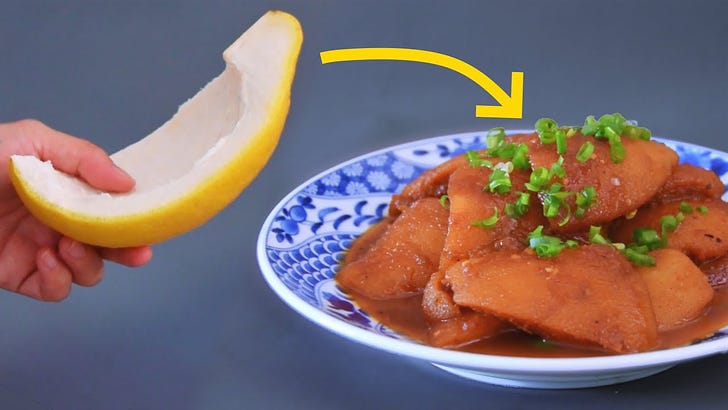Cantonese Braised Pomelo Skin (鲮鱼焖柚皮)
How to eat pomelo skin! This is a really classic Cantonese dish, and an awesome use of the pith of the pomelo.
Braised pomelo skin is a classic Cantonese dish. Now, if you're new to the dish this whole concept of a 'braised pomelo skin' is probably hitting you in one of two ways – first, if you're like a lot of people, you might've been unaware that you could braise a pomelo skin. Or barring that, for those in the West I know some of you might just be scratching your head right now thinking "wait… what's a pomelo again"?
And on that front, as tempted as I am to go into a treatise on citrus taxonomy, I'll save my gas for another day. The short story is that most of the citrus plants you know and love are actually hybrids between one of three ancestral citrus plants: Mandarins, Citrons, and, of course, Pomelos. What you know of as oranges are actually a cross between Pomelos and Mandarins, and Grapefruits a backcross between Oranges and Pomelos.
So if you've never had one, you could maybe think of pomelo as sort of like a sweeter grapefruit, or maybe an orange minus the mandarin. And in addition to being a nice fruit, pomelos've also got this super thick pith to them, which these days is usually just tossed in the rubbish bin (or inside the fridge to clear the smell). But back in the day, people here would use their pomelos nose to tail, and with a bit of technique they would turn that thick pith into a real show-stopper of a dish. So, as befitting an old school Cantonese dish, the recipe here is shared with us by an old school Cantonese guest cook… Steph’s Dad, Dawei.
Generally you’d see braised pomelo skin at some old school/high end Cantonese restaurants, and while those can be tasty, you never really know that you're eating a citrus skin. Because they'll generally peel the skin off, you end up losing pretty much all of it's citrus-y flavor. The way Dawei does here retains that flavor, and definitely makes for our favorite braised pomelo skin we've ever had.
Braised Pomelo Skin with Fish Stock (鲮鱼焖柚皮)
Large pomelo (柚子/沙田柚), 1.
For the soup:
Fish bones and heads (mud carp/鲮鱼) or shrimp shells, 250g.
Water, 1L.
Garlic, ~1 clove.
Liaojiu (Shaoxing wine, 料酒/绍兴酒), ~1 tbsp.
Seasoning for the braise:
Salt, ½ tsp.
Sugar, ½ tsp.
White pepper powder (白胡椒粉), ¼ tsp.
Dried shrimp roe (虾子), ½ tbsp or dried shrimp powder (虾米打粉), 1 tsp.
Slurry for the braise:
Cornstarch (生粉), 1 tsp.
Dark soy sauce (老抽), 1 tsp.
Water, 2 tbsp.
Lard (猪油), 3 tbsp. [1 tbsp for soup, 1 tbsp to start braise, 1 tbsp to finish braise]
Scallions, for finishing.
Process:
Peel 1 large pomelo.
Grill the pomelo skin until completely black. Dunk in water & scrape off the charred bits. Change water between pieces.
Soak and squeeze the skin 8-9 times or until the water is clear & no longer slimy.
Cut off the hard end of the pomelo skin, then cut into three pieces. Soak and squeeze once more time.
Blanch the skins for ~5 minutes, covered. Transfer to cool water, change the water, and squeeze once last time.
Make the fish soup: Fry 250g fish bones in 1 tbsp lard until slightly browned, ~90 seconds. Add 1L cool water. Cook for ~5 minutes, then strain. (If using shrimp shells, cook for 30-45 minutes)
Braise the pomelo skins: Fry 1 clove of garlic in 1 tbsp lard, then add ~1 tbsp Shaoxing wine. Quick mix, add soup back in, season with ½ tsp salt & ½ tsp sugar, add pomelo skins. Covered and boil for ~5 minutes or until a chopstick can poke through the skin.
Season with ¼ tsp white pepper and ½ tbsp dried shrimp roe (or 1 tsp dried shrimp powder), add 1 tbsp lard, thicken with the slurry (1 tsp cornstarch, 1 tsp dark soy sauce, 2 tbsp water). Cook for ~30 more seconds, sprinkle over some sliced scallions.
Note for Dried Shrimp Powder: Blitz ~20 dried shrimp in a blender or ~10 in a spice grinder/food processor. If stringy, finely mince to disappear into the braise.
Note for Dried Shrimp Roe: Apparently Dried Shrimp Roe IS available on Amazon. Last time we used the ingredient (Wonton Noodles), it wasn't. Still, hardly seems to be a mainstay at most Chinese supermarkets in the West.




this is one of those dishes that i’ve only had a few times in my life and every time i want to eat the whole dish! thank you for posting this! i have two huge pomelo in the fridge and im going to try making those
Oh just realised this was posted last year - don't know how I missed it 🥹